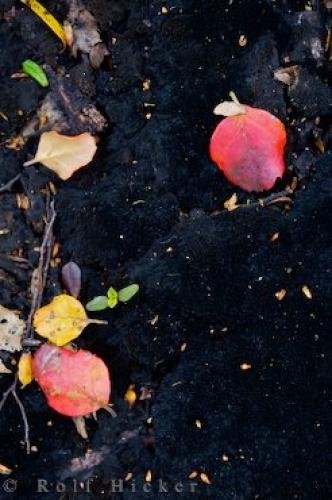Photo: Black Sooty Mould Fungus Nelson Lakes National Park New Zealand
Colourful leaves stand out against the Black Sooty Mould Fungus along the Bellbird Walk at Lake Rotoiti in Nelson Lakes National Park on the South Island of New Zealand. This black fungus is a black coating along the surface.
Colourful leaves stand out so starkly against the Black Sooty Mould Fungus that can be found along the Bellbrid Walk at Lake Rotoiti in Nelson Lakes National Park, on the South Island of New Zealand. This type of fungus appears as a dark black coating on the surface of soil, but also trees, fruit and even leaves. Unlike the fact that it looks like it has diseased the soil and the surrounding growth, Black Sooty Mould Fungus is not a disease and it is actually developed by insect honeydew.
Black Sooty Mould Fungus grows when honeydew drops on the ground or a leaf for example and then sooty mould spores that are windblown stick to the honeydew and this provides an ideal platform for growth. It is when the spores germinate that they produce fungal strands that are black and these eventually cover the surface and give this black appearance. ... continue below the picture...
Black Sooty Mould Fungus Nelson Lakes National Park New Zealand

Fungus, Nelson Lakes National Park, New Zealand.
Pictures from photo gallery "Arctic Pictures"
This picture is part of the photo album "New Zealand Kiwiana Tour" - there are more beautiful images waiting for you.
Related stock photo galleries, pictures & travel ideas:
Black Sooty Mould Fungus Nelson Lakes National Park New Zealand
... Depending on the surface, this fungus can affect the growth of some plants as it shuts out light and hinders the ability of plants to grow. When this mold is developed, it also comes with honeydew producing insects, and these must be managed in order to control the fungus.
This Black Sooty Mould Fungus can be washed off some surfaces, but if you do this you must control the insect population or the mould will come back. You can use chemical sprays to get rid of the insects, but you should always check before doing so as they can harm the plants more than the insects.
Colourful leaves on Black Sooty Mould Fungus along the Bellbird Walk at Lake Rotoiti, Nelson Lakes National Park, South Island, New Zealand
Technical Information:
I photographed this photo with the digital SLR camera model Canon EOS-1Ds Mark II, aperture of f/7.1, exposure time of 1/4 sec. on ISO 100, as always I used a original Canon Lens, the focus lenght for this picture was 180mm.
Colourful leaves stand out against the Black Sooty Mould Fungus along the Bellbird Walk at Lake Rotoiti in Nelson Lakes National Park on the South Island of New Zealand. This black fungus is a black coating along the surface.
